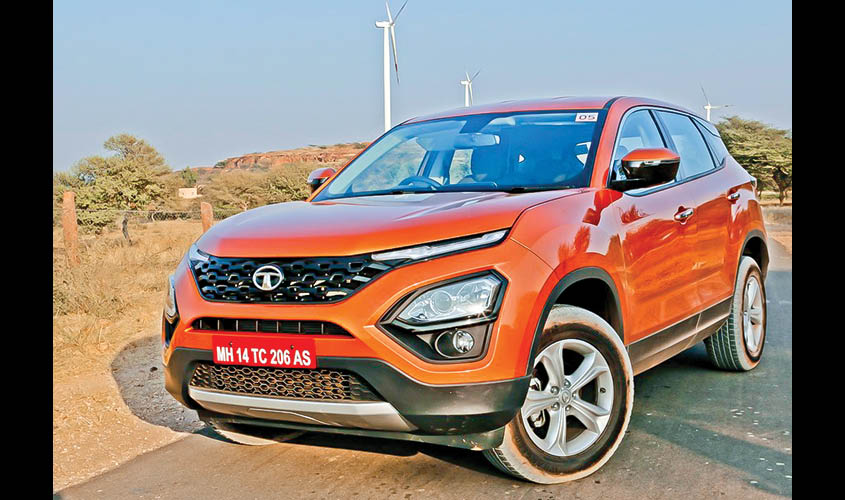The world of SUVs is getting bigger and better. A lot of them have been launched just this year and the year 2019 too promises to begin with a bang for the SUV lovers. That is because Tata Motors will launch the much awaited Harrier, their first ever product built on the Land Rover architecture. We first saw the car in the concept form at the Auto Expo earlier this year where it was christened as the H5X. And now I finally got a chance to get behind its wheels a few days ago on the fantastic roads of Rajasthan.
Looks
The fact that the Harrier has already generated a huge buzz is because of the way it looks. It looks a true blue SUV and just like all recent cars from the brand the emphasis on design is very evident. The Harrier is also the first car to get the Impact 2.0 design theme so it does not look similar to any other Tata, apart from maybe the signature grille which misses out on chrome. The big talking point is the LED lamps which actually finds a place above the headlamps and that makes the front look quite unique. The profile too is quite appealing with the square wheel arches and use of chrome on the door handles and window line. The 17 inch wheels look quite alright when it comes to proportions of the car. What works on the rear are the split tail lamps that merge well with the black bar. Overall Tata Motors haven’t departed too much from the concept design and that is worthy of appreciation.

Interiors
The Impact 2.0 design theme works well here too. It’s a car that’s big on dimensions so there’s a lot of space on offer. This also means that the seats are quite big and they’re comfortable as well. There are lot of materials on offer including faux wood and tan leather. The 8.8 inch infotainment screen is the highlight here as it is the best you’ll see on any car from Tata Motors. It is very clear, responsive and easy to use. However the same cannot be said about the quality of reverse camera feed. Also it’s really nice the way the AC vents have been integrated with the touch screen. The system is compatible with Apple car play and Android auto. And there’s another 7 inch TFT screen also given this time in the instrument cluster. The size of the steering wheel can certainly be a bit smaller and the car misses out on some important features like powered driver seat, auto diming mirror and a lock unlock button. But do not miss the cool aircraft inspired handbrake lever that also saves space. The second row gets a centre armrest and very functional AC vents on the B-pillar. Boot space is just about satisfactory at 425 liters.
Engine
The Tata Harrier borrows its heart from Fiat. The 4 cylinder 2.0 liter multijet Diesel engine has been christened as Kyrotech and churns out 140 PS along with delivering 350 Nm of peak torque. The engine is a bit noisy to begin with the cabin becomes relatively quieter at higher speeds. And there’s good power on offer in almost all bands. The 6-speed manual gearshift is a bit notchy at times and throws too are a bit long and that may impact your drive experience. The car gets Eco, City and Sport driving modes and that’s good because you can choose if you want more efficiency or superior performance or balance between both. However the Harrier will not get a Petrol option, neither will get automatic or all wheel drive variants. But despite that the rough road and wet modes in the ESP system do the job of bailing you out from tricky situations as we experienced at the Khimsar Sand dunes.
Ride & Handling
A light responsive steering and a light clutch make the Harrier an easy car to drive despite its rather big dimensions. The handling is quite impressive and even quick lane changes at high speeds do not unnerve you. The car inspires confidence which augers well for the occupants. The suspension works well too and the Harrier is more than capable of taking on the all the bumps and potholes with ease. The Omega architecture jointly developed with Land Rover does the duty quite well here.
Verdict
The Tata Harrier is a mix of a lot of hits and few misses. Considering the segment it is going to enter not seeing a few features is a bit disappointing. But its USP overshadow that to a large extent—the 3 biggest attributes being Design, Interiors and Safety which includes 4 airbags and Hill descent control. There’s some indication on the pricing that may range from Rs. 16-21 lakhs (on-road) which looking at the product may be a little on the higher side. But if Tata launches it at a somewhat lower price in January the Harrier will make a very strong case for itself.
Shams Naqvi is an anchor/producer for the News X motor show Living Cars

